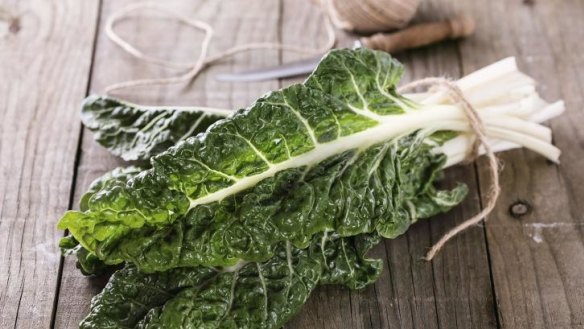Owen Pidgeon: How to grow silverbeet in Canberra gardens

It is worth planting out several silverbeet seedlings or sowing a couple of rows of seed at this time of year to have a good supply of vitamin-rich leaves over many months. It is an excellent source of beta-carotene as well as a good natural source of iron and potassium.
This is the cousin of beetroot which has been grown in Mediterranean countries as well as Portugal and Spain for millennia. The Roman cohorts took the seeds of this leafy beet into central and eastern Europe and it eventually arrived in China in the 17th century. It is also known as Swiss chard, but that is intriguing in that the word "chard" is derived from a French word, "carde".
Silverbeet is an easy vegetable to grow and can tolerate hot weather and even quite dry conditions. It grows best in full sun in a rich garden bed that is well drained. It takes just seven to 10 days for seeds to germinate and about eight or nine weeks for a full crop to be produced over summer.
Plant out a second and third little garden bed over the next month to keep up your home supply through to autumn. Direct sowing means your little plants do not have to experience transplant shock, but if you do buy a punnet of seedlings, water them in well and cover with good-sized garden pots for three to four days to protect them from the hottest time of the day.
This is a vegetable that needs to be pushed along; quick growth produces the most tender, tasty leaves. Before planting, dig in lots of rotted manure and old compost. Mix in some additional organic pelletised fertiliser. Sow your seeds 15 millimetres deep and allow between 30 and 35 centimetres between plants. Every fortnight provide the plants with a liquid fertiliser supplement.
There are quite a number of very colourful varieties now available in Australia. Ruby chard has impressive deep crimson stems and dark green crumpled leaves. It is a very productive variety and you can pick outside leaves continuously. Rainbow chard produces a beautiful array of coloured stems, from red through to yellow and green. When picked very young, these can brighten up your mixed salads, just as they have brightened up your garden while growing.
Lucullus produces large but soft foliage that is heavily savoyed. The leaves are a pale yellowy-green colour. It is another heavy cropper. This one has been named after a famous Roman general who loved to eat very big dinners. Erbette is an Italian chard with a good flavour and excellent texture. Fordhook giant is the regular dark green silverbeet with very white veins and stems.
If you are looking for a variety with some similarity to spinach, then plant out Perpetual. It has much smaller, thinner, smooth leaves of an apple green colour. It is finer in texture with a slightly subtle taste, so chefs will often select this variety for their mains dishes.
Silverbeet and feta filo triangles
8 young silverbeet leaves
1 medium onion
¼ cup fresh mint, chopped
½ cup chopped parsley
1 tbsp virgin olive oil
2 free-range eggs
200g feta
60g parmesan, grated
6 sheets filo pastry
80g butter, melted
salt and pepper
Trim off the stems of the silverbeet and thinly slice. Shred the silverbeet leaves. Steam the silverbeet until a little wilted. Saute the onion in olive oil until it is translucent and soft. Break the eggs into a large bowl and whisk. Mix in the silverbeet, onion, mint and parsley. Crumble the feta and add, along with the parmesan, to the mixture.
Take one large sheet of filo pastry and cut lengthways with a sharp knife to make long strips approximately 10 centimetres in width. While preparing the strips, keep the remaining pastry under a damp tea towel to prevent drying out.
Brush each strip with melted butter. Place a heaped teaspoon of the silverbeet mixture onto the middle of the pastry, at the bottom of the strip. Fold the pastry diagonally over the mixture to form a triangle, and keep folding over until all the pastry is rolled around. Brush with butter and lay on a baking tray. Cook for around 15 minutes, at 190C, until golden brown.
This week in the garden
* Plant out rocket, mizuna, pak choi and a selection of the loose leaf lettuces to provide for variety in the salad bowls.
* Plant one or two rows of cucumbers and zucchinis to follow on your earlier plantings.
* Keep tying up your tomatoes as they grow rapidly after the recent rains. Remove laterals to help with good production.
* Look to planting the seeds of cabbage, cauliflower and broccoli to get your winter vegetable crops under way.
* Apply more mulch to garden beds to keep water loss down and help the soil to stay cool as the hot days return.
* Keep weeding around your rows of potatoes and hill up to increase production.
Owen Pidgeon runs the Loriendale Organic Orchard near Hall.
Restaurant reviews, news and the hottest openings served to your inbox.
Sign up